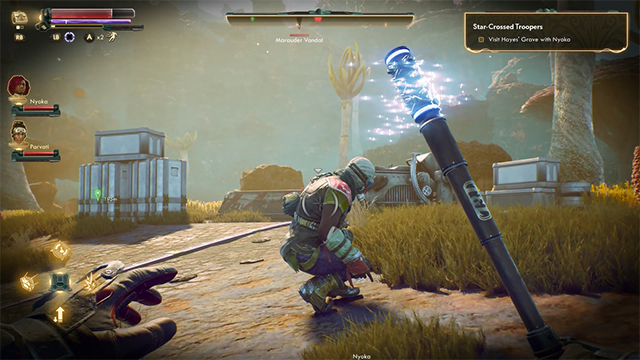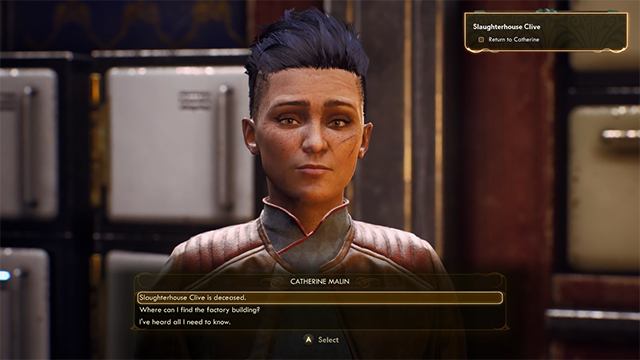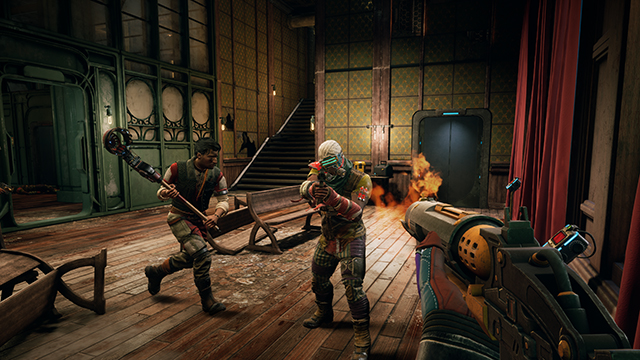The Outer Worlds is one of the most anticipated games coming later this year. But instead of being an RPG that aims to take all of your time, The Outer Worlds has positioned itself as a modestly sized role-playing game. It’s a unique choice in 2019 and Carrie Patel, senior narrative designer at Obsidian, sat down with us to talk about the game’s scope as well as how the team makes its missions and where the title fits in 2019.
GameRevolution: This isn’t like million-hour RPG like some of the other RPGs on the market. Why take that approach?
Carrie Patel: I think for us the focus for us has always been giving the player a polished and story-driven experience since a lot of our games are known for their stories. We want to make sure that all the content we are giving the player is really tightly honed and gives them a cohesive experience. We don’t want to jam the content for the sake of inflating our hours. So I think that what we ended up with feels right for the game we are making, which isn’t a AAA, gigantic budget blockbuster kind of game.
But I think The Outer Worlds is going to be a really strong polished single-player RPG for people that like our choice and consequence systems.
ALSO: The Outer Worlds might be the best 2011 game to come out in 2019
GR: Speaking of, the quest we played today gave us a lot of options. Are a lot of the quests in The Outer Worlds like that?
CP: Yeah. We do try to provide different dialogue, stealth, combat methods, and combinations thereof to get through most of our content. So we tried to let players have those options, especially for longer quests like the Slaughterhouse Clive mission you played.

GR: Since I am a caveman, I cut him down and killed him. How else could I have done that mission and found the other options?
CP: We handle it differently in every quest. But when we offer these options and branches, we try to put them in the player’s path so it’s not this entirely obscure set of things you have to do to find another way to do a mission.
Like [in that Slaughterhouse Clive mission] Catherine tells you that she wants you to shut down his operations and you can do that however you want. That already presents the idea that you can sabotage them or you can maybe go talk to him and intimidate him and talk him down or you can straight up kill him.
She’s giving you the objective and how you go about achieving that is up to the player. And the player goes through the quest and they can choose to do those things and they can deal with Clive directly. Like you can also turn it back on Catherine and ally with Clive.
GR: Obviously, this game gives off a lot of New Vegas vibes but it is a lot more of a shooter. What was the reason to make it more of a shooter?
CP: I think especially for players who enjoy first-person style combat, we wanted to make sure our combat system was really robust. We have a number of different types of weapons from ranged to melee. And some melee weapons are really good especially if you combine them with a stealth build and sneak around with them. It’s immensely satisfying.

GR: It’s not a game like Dishonored that’s more a stealth-first kind of game, right?
CP: Right, right. It’s not as much of a stealth game as Dishonored but it is a game where stealth is part of how you can approach a situation. But you can get through the game without killing anybody. We certainly wanted the combat and shooting to feel really good because it’s the most straightforward way to engage with a lot of enemies.
GR: Since it is a lot like New Vegas, what has Obsidian done to bring The Outer Worlds up to 2019 standards?
CP: The biggest thing is that it is a new IP. And obviously we were excited to create something in a new world and we’re hoping our fans will also be excited to experience a new world. But it still has some of that dark humor that fans will recognize. But it also becomes its own thing.
Mechanically, we’ve really focused on honing the gunplay and how that stuff feels. We also have the Flaws system, which is an interesting way to let your play experience shape your character as you go but only as you want. But only if you want it. We recognize that some players may not like that but ultimately taking Flaws is optional.
Our higher difficulty, Supernova, even has survival elements rolled in like hunger, thirst, and exhaustion. You have to eat, sleep, and drink regularly. Again, with a game like this, we’re trying to allow the player to approach it broadly enough to satisfy a lot of different playstyles.
GR: Obsidian usually makes games on Earth or Earth-like planets. Why go to space?
CP: Part of it is a lot of us at the company enjoy sci-fi. A lot of classic golden age science fiction was a lot of the inspiration for the feel of this world. A lot of this ties into exploring these new star systems and colonizing and seeing what is out there.
A lot of it is, for us, letting the player experience a new setting that is not on Earth. And that gave us the freedom to really design something with very few constraints that was exciting for us to build. It would also let us lean on our strengths as worldbuilders and give players something they hadn’t seen before.

GR: As a narrative designer, how do you narratively design a game like The Outer Worlds with a lot of possibilities?
CP: Carefully and deliberately and with lots of documentation. As with any game this size, a lot of it does ride on having good documentation. So we have documentation for nitpicky things like the standards of the format of our writing like how long nodes should be and what kinds of words are in this kind of setting and what ones are not.
We also have documentation for the setting itself and story so anytime there is a mundane question, a writer or level designer has about the world or the content they’re making, there is documentation to guide that.
GR: So like a codex?
CP: Basically, yeah. With any set of design, we start with a paper design. Like if a quest has multiple outcomes, that stuff should all be documented. Here are the NPCs involved. Here’s the size of the space the quest takes place in. Here are all of the different outcomes. Here are all of the different ways to get through it. And here’s what we estimate the complexity of it to be. And everyone involved signs off on that and they can start to build it together.
So the writer and designer can start creating dialogue with an understanding of what the player will be doing and where they will be going. Meanwhile, the level designer is creating the play space and adding enemies and scripting in behaviors so the quest functions how we want.
It’s about being deliberate and coordinating well with all the people you’re working with. Invariably, there will be something you didn’t expect, which is why we playtest our own content to catch these things. Like does it make sense or is it interesting?
GR: Can you talk more about Dumb dialogue?
CP: Dumb dialogue is a feature of a lot of classic Obsidian RPGs where instead of punishing a player for making a really low intelligence character, we give them something fun and a way to be amused by it. We include options only for low intelligence players that let them have fun with the lack of awareness and common sense in the world.







